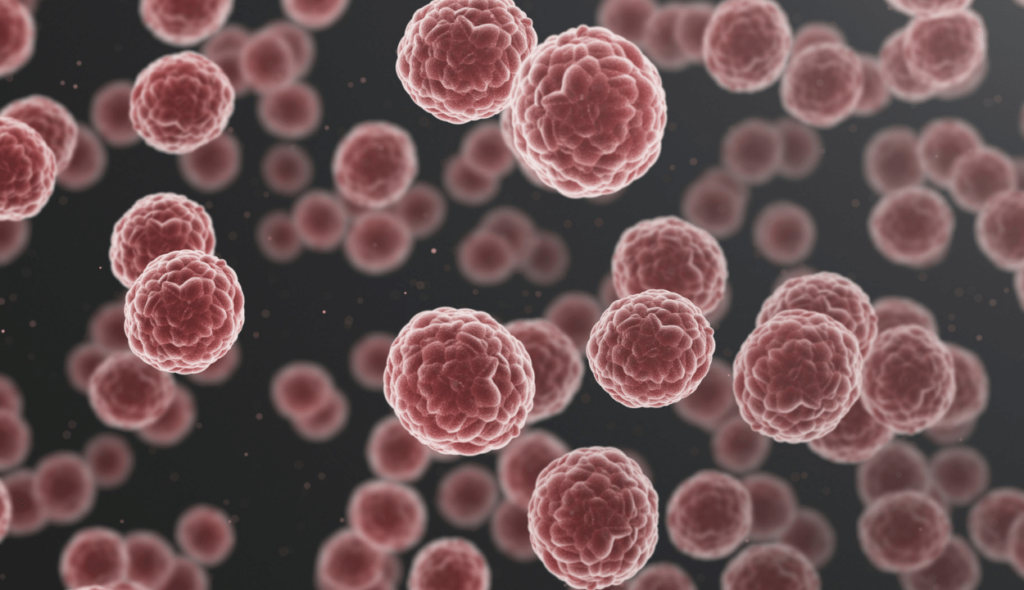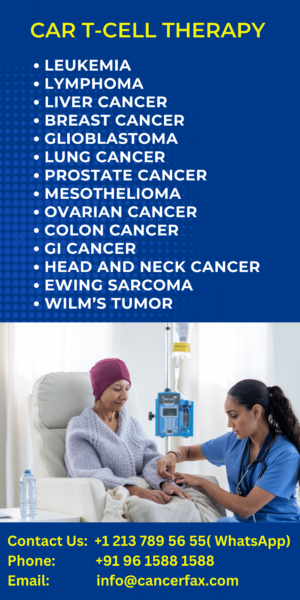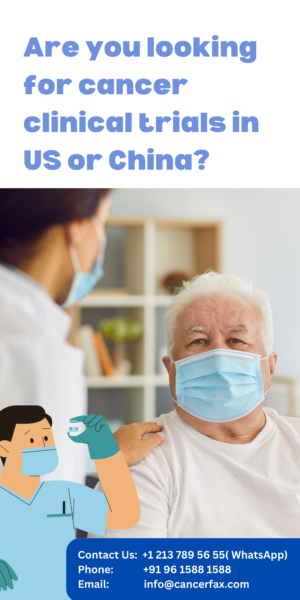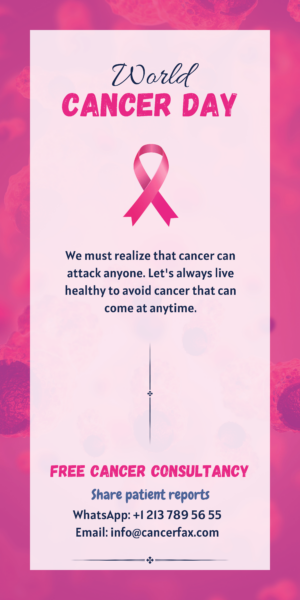Kaposi sarcoma
Kaposi sarcoma

An instance of cancer that develops in the lining of blood and lymph vessels is kaposi’s sarcoma. On the legs, foot, or face, Kaposi’s sarcoma tumours (lesions) often present as painless purplish spots. Additionally, lesions may develop in the mouth, lymph nodes, or vaginal region. Lung and digestive tract lesions are possible in severe Kaposi’s sarcoma.
Human herpesvirus 8 infection is the fundamental cause of Kaposi’s sarcoma (HHV-8). Because the immune system controls it, HHV-8 infection typically has no symptoms in healthy individuals. However, HHV-8 has the capacity to cause Kaposi’s sarcoma in persons with compromised immune systems.
The risk of Kaposi’s sarcoma is higher in those who have human immunodeficiency virus (HIV), the virus that causes AIDS. HIV impairs the immune system, allowing HHV-8-carrying cells to proliferate. The distinctive lesions develop by unidentified methods.
Patients who have organ transplants and take medications to suppress their immune systems increase their chance of developing Kaposi’s sarcoma. However, compared to AIDS patients, the disease tends to be milder and simpler to manage in this population.
Older males of Eastern European, Mediterranean, and Middle Eastern heritage can develop a different kind of Kaposi’s sarcoma. This malignancy, sometimes referred to as classic Kaposi’s sarcoma, advances gradually and normally poses few life-threatening issues.
In equatorial Africa, a fourth variety of Kaposi’s sarcoma that affects persons of all ages can be found.
Types of Kaposi sarcoma
Epidemic (AIDS-associated) Kaposi sarcoma
Epidemic or AIDS-related KS is the most prevalent kind in the US. People who have HIV, the virus that causes AIDS, have this kind of KS.
Human immunodeficiency virus is referred to as HIV. An HIV-positive person does not necessarily have AIDS, but the virus can remain in the body for a long period, frequently for many years, before producing serious illness. When a person’s immune system has been severely compromised by the virus, the person develops AIDS, which makes them susceptible to infections like the Kaposi sarcoma-associated herpesvirus (KSHV) and other health issues like KS.
KS is regarded as an AIDS-defining condition. This means that when KS manifests in an HIV-positive individual, AIDS is the official diagnosis (and is not just HIV-positive).
Less AIDS-associated KS cases have been reported in the US as a result of treating HIV infection with highly active antiretroviral therapy (HAART). However, some patients may experience KS during the initial stages of HAART therapy.
HAART frequently prevents the development of advanced KS in the majority of HIV patients. Even so, KS can happen in patients whose HIV is under good control because to HAART. It is crucial to continue HAART even if KS manifests.
In places where obtaining HAART is difficult, KS in AIDS patients can progress swiftly.
Classic (Mediterranean) Kaposi sarcoma
Older adults with a Mediterranean, Eastern European, or Middle Eastern ancestry are more likely to develop classic KS. Men are more likely than women to have classic KS. Most people have one or more lesions on their legs, ankles, or foot soles. Lesions in this type of KS do not spread as rapidly or form new lesions as frequently as those in other types of KS. Although not as weak as in those with epidemic KS, the immune system of those with classic KS may nonetheless be less robust than usual. The immune system can normally deteriorate a little as we age. People who already have a KSHV infection (Kaposi sarcoma-associated herpesvirus) are more likely to acquire KS when this occurs.
Endemic (African) Kaposi sarcoma
Endogenous KS, often known as African KS, affects inhabitants of Equatorial Africa. Africa has a substantially greater prevalence of Kaposi sarcoma-associated herpesvirus (KSHV) infection than other regions of the world, which increases the risk of KS. Since KS affects a wider range of people, including children and women, it is likely that other immune-depressing factors in Africa (such as malaria, other chronic illnesses, and malnutrition) also contribute to the disease’s emergence. Younger persons are more likely to have endemic KS (usually under age 40). Rarely do children before puberty exhibit a more aggressive type of endemic KS. This type can advance swiftly and typically affects the lymph nodes and other organs.
Historically, the most prevalent form of KS in Africa was endemic. The epidemic type then spread as AIDS became more prevalent in Africa.
Iatrogenic (transplant-related) Kaposi sarcoma
Iatrogenic, or transplant-related, KS is the term used to describe KS that develops in persons whose immune systems have been reduced as a result of an organ transplant. The majority of transplant recipients require medication to prevent their immune system from fighting (rejecting) the new organ. However, these medications raise the risk that someone infected with KSHV (Kaposi sarcoma-associated herpesvirus) will develop KS by impairing the body’s immune system. KS lesions frequently disappear or shrink when immune-suppressing medication is stopped or reduced in dosage.
Signs and symptoms of Kaposi sarcoma
Lesions on the skin are the typical first sign of kaposi sarcoma (KS). The lesions might be brown, red, or purple in colour. KS lesions might be lumps, plaques, patches, or flat lesions that are not elevated above the surrounding skin (called nodules). Although they can emerge elsewhere, the legs or face are where KS skin lesions typically originate. Sometimes, lesions on the legs or in the groyne can prevent fluid from leaving the legs. Legs and feet may experience excruciating swelling as a result.
Additionally, mucous membranes, or the inside linings of several body parts, such as the inside of the mouth and throat, the outside of the eye, and the inner part of the eyelids, can develop KS lesions. Typically, the lesions are neither unpleasant nor irritating.
Additionally, KS lesions can occasionally develop in other body regions. A portion of an airway may be blocked by lung lesions, resulting in shortness of breath. Abdominal pain and diarrhoea may be brought on by lesions that form in the intestines and stomach.
KS lesions might bleed on occasion. If the lesions are in the lung, you can cough up blood and experience shortness of breath as a result. Bowel movements may become bloody or black and tarry if the lesions are in the intestines or stomach. Blood loss from stomach and intestine lesions can occur slowly enough that blood is not immediately apparent in the stool, but over time, the blood loss might result in low red blood cell levels (anemia). This may result in signs including exhaustion and breathing difficulties.
Diagnosis of Kaposi sarcoma
When a person visits the doctor due to indications or symptoms they are experiencing, the doctor frequently discovers kaposi sarcoma (KS). KS can occasionally be discovered during a standard physical examination. Additional testing will be required to confirm the diagnosis if KS is suspected.
Medical history and physical examination
If your doctor has any reason to suspect that you may have KS, you will be questioned about your medical history in order to obtain information regarding any previous illnesses, procedures, sexual activity, and other potential exposures to Kaposi sarcoma-associated herpesvirus (KSHV) and HIV. Your symptoms, as well as any skin growths or lesions that you may have observed, will be inquired about by the physician.
Your doctor will search for KS lesions on your skin as well as the inside of your mouth as part of a comprehensive physical exam that they will do on you. There are instances in which KS lesions grow within the rectum (the part of the large intestine just inside the anus). During an exam, a doctor might be able to feel these lesions with a gloved finger. Because KS in the intestines can cause bleeding, the doctor may also inspect the stool to see if there is any occult (unseen) blood present.
Biopsy
The only way for a physician to know for certain that a lesion was brought on by KS is for them to remove a little piece of tissue from the lesion and send it off to a laboratory for analysis. This procedure is known as a biopsy. In many cases, KS can be diagnosed by a clinician with specialised training known as a pathologist, who examines the cells in the biopsy sample in the laboratory.
A punch biopsy is often what the doctor will use to extract a very little sample of tissue when diagnosing skin lesions. This type of biopsy is round. An excisional biopsy is the type of biopsy that is performed when the entire lesion is removed. The use of only local anaesthetic is typically sufficient for these procedures (numbing medicine).
Other locations, such as the lungs or the intestines, might also have lesions biopsied during other procedures, such as bronchoscopy or endoscopy, which will be discussed in more detail in the next paragraphs. It is common practise not to perform biopsies on persons who are already aware that they have Kaposi’s sarcoma (KS) because lesion biopsies in these regions can on occasion result in significant bleeding.
X-Ray
You might get an x-ray of your lungs to check for the presence of KS. In the event that the x-ray reveals something out of the ordinary, more testing, such as a CT scan, may be required in order to definitively determine whether or not the patient has KS or another condition.
Chest x-rays can be used on patients who are already aware that they have KS in the lung to evaluate how well the disease is responding to treatment.
Bronchoscopy
A bronchoscopy is a diagnostic procedure that provides the physician with a view of the patient’s windpipe (also known as the trachea) and the major airways of the lungs. This operation is typically carried out if you are experiencing issues such as shortness of breath or coughing up blood, or if the chest x-ray or CT scan reveals something wrong in your chest. Any one of these could be an indication that chronic KS is present in the lungs.
You will be given a mild anaesthetic and put to sleep before the bronchoscopy procedure begins. The physician will then put the bronchoscope, which is a thin, flexible, lighted tube with a little video camera attached to the end, into the lungs by way of the mouth, the windpipe, and the back of the throat. Through the use of the bronchoscope, a biopsied sample can be obtained from an atypical area that the physician suspects may be KS. Bronchoscopy combined with biopsies can also be used as a diagnostic tool for other lung conditions that are common in people living with AIDS, such as pneumonia.
Upper endoscopy (also called esophagogastroduodenoscopy, or EGD)
An upper endoscopy is a procedure that examines the lining of the upper digestive tract, including the oesophagus, stomach, and the beginning of the small intestine. Before beginning this treatment, you will first be given medications to put you to sleep. After that, the physician manoeuvres an endoscope, which is a thin, flexible, lighted tube with a miniature video camera attached to one of its ends, down the patient’s oesophagus, through the stomach, and then into the small intestine. The physician is then able to diagnose conditions such as ulcers, infections, and KS lesions.
If the doctor notices an abnormal spot, they can take a biopsy of it using small surgical instruments that are passed via the endoscope.
Colonoscopy
Colonoscopy is a procedure that is used to inspect the interior of the large intestine (colon and rectum). In order to perform this test, the colon and rectum will need to be thoroughly cleaned of any stool that may be present. This usually requires consuming a significant amount of a liquid laxative the night before the procedure as well as the morning of it, in addition to spending a significant amount of time in the bathroom.
Just prior to the treatment, you will be given medication through an intravenous (IV) line in order to calm or potentially put you to sleep (sedation). The next step involves passing a colonoscope, which is a long, flexible tube with a light and video camera attached to the end, into the rectum and into the colon. Any suspicious regions that are located can have a biopsy taken.
Capsule endoscopy
The small intestine can be viewed through a process known as capsule endoscopy. Because it does not involve the use of an endoscope, it cannot be considered a true form of endoscopy. Instead, you take a capsule roughly the size of a huge vitamin pill that contains a light source and a very small camera. You ingest this capsule to take the picture. The capsule is broken down in the stomach and then moved on to the small intestine, just like any other medication.
It captures thousands of images while it moves through the small intestine, which typically takes around 8 hours. While you go about your normal day, these photos are wirelessly sent to a device that you wear around your waist, and while you do so, it records and stores them. After that, the photos can be transferred onto a computer, and the physician can watch them as a video on the device.
During a motion of the bowel that is considered to be normal, the capsule is expelled from the body through the faeces and is then eliminated. One of the drawbacks of this test is that it does not provide the opportunity for the physician to do a biopsy on any suspicious spots. Before the exam, you will most likely be instructed not to consume any food or liquids for approximately 12 hours.
Double balloon enteroscopy
An further method for examining the small intestine is called a double balloon enteroscopy. Endoscopy in its more conventional form is unable to peer very deeply into the small intestine because of its length and the numerous bends that it contains. The use of a specialised endoscope that is composed of two tubes, one of which is inserted within the other, allows for these issues to be circumvented using this approach. For the purpose of this examination, you will be sedated with medication administered intravenously (IV), and you may even be put under for the duration of the procedure (so that you are asleep).
After that, the endoscope is put into the patient’s body through either the mouth or the anus, depending on which section of the small intestine has to be viewed on the device’s screen. Once the endoscope has been inserted into the small intestine, the inner tube, which has the camera attached to the end of it, is advanced approximately one foot while the doctor examines the intestinal lining. After that, an anchor balloon is inflated and placed at its terminus. After this step, the outer tube is moved forward until it is almost at the end of the inner tube, and a second balloon is used to secure it in place.
This procedure is carried out numerous times in order to provide the physician with a view of the gut that is one foot at a time. In the event that something wrong is detected, the physician may even do a biopsy. This process is more complicated than capsule endoscopy (and can take hours to finish), but it has the advantage of allowing the doctor to biopsy any lesions that are seen during the operation.
The liver, spleen, heart, and bone marrow are just some of the organs that might be impacted by KS. When KS is already suspected in a person based on the results of biopsies of other tissues, such as the skin, lungs, or intestines, it is not always necessary to take a biopsy from these locations.
Stages of Kaposi sarcoma
The AIDS Clinical Trials Group (ACTG) system for AIDS-related KS considers 3 factors:
- The extent of the tumor (T)
- The status of the immune system (I), as measured by the number of CD4 cells (a specific type of immune cell) in the blood
- The extent of systemic illness (S) within the body (how sick is the person from the cancer or the HIV)
Under each major heading, there are 2 subgroups: either a 0 (good risk) or a 1 (poor risk). The following are the possible staging groups under this system:
T (tumor) status
T0 (good risk): Localized tumor
KS is only in the skin and/or the lymph nodes (bean-sized collections of immune cells throughout the body), and/or there is only a small amount of disease on the palate (roof of the mouth). The KS lesions in the mouth are flat rather than raised.
T1 (poor risk): The KS lesions are widespread. One or more of the following is present:
- Edema (swelling) or ulceration (breaks in the skin) due to the tumor
- Extensive oral KS: lesions that are nodular (raised) and/or lesions in areas of the mouth besides the palate (roof of the mouth)
- Lesions of KS are in organs other than lymph nodes (such as the lungs, the intestine, the liver, etc.). Kaposi sarcoma in the lungs can sometimes mean a worse prognosis (outcome).
I (immune system) status
The immune status is assessed using a blood test known as the CD4 count, which measures the number of white blood cells called helper T cells.
I0 (good risk): CD4 cell count is 150 or more cells per cubic millimeter (mm3).
I1 (poor risk): CD4 cell count is lower than 150 cells per mm3.
S (systemic illness) status
S0 (good risk): No systemic illness present; all of the following are true:
- No history of opportunistic infections (infections that rarely cause problems in healthy people but affect people with suppressed immune systems) or thrush (a fungal infection in the mouth).
- No B symptoms lasting more than 2 weeks. B symptoms include:Unexplained fever; night sweats (severe enough to soak the bed clothes); weight loss of more than 10% without dieting
- Karnofsky performance status (KPS) score of 70 or higher. This means you are up and about most of the time and able to take care of yourself.
S1 (poor risk): Systemic illness present; one or more of the following is true:
- History of opportunistic infections or thrush
- One or more B symptoms is present
- KPS score is under 70
- Other HIV-related illness is present, such as neurological (nervous system) disease or lymphoma
Overall risk group
Once these features have been evaluated, patients are assigned an overall risk group (either good risk or poor risk). In fact, since highly active antiretroviral therapy (HAART) became available to treat HIV, the immune status (I) has become less important and is often not counted in determining the risk group:
- Good risk: T0 S0, T1 S0, or T0 S1
- Poor risk: T1 S1
Treatment of Kaposi Sarcoma
The treatment for Kaposi’s sarcoma varies, depending on these factors:
- Type of disease. Historically, AIDS-related Kaposi’s sarcoma has been more serious than classic or transplant-related disease. Thanks to increasingly effective antiviral drug combinations and improved prevention of other AIDS-related infections, Kaposi’s sarcoma has become less common and less severe in people with AIDS.
- Number and location of lesions. Widespread skin lesions and internal lesions require different treatment from isolated lesions.
- Effects of the lesions. Lesions in the mouth and throat make eating difficult, while lesions in the lung can cause shortness of breath. Large lesions, particularly on the upper legs, can lead to painful swelling and difficulty moving around.
- General health. The immune system impairment that makes you vulnerable to Kaposi’s sarcoma also makes certain treatments, such as powerful chemotherapy drugs, too risky to try. The same is true if you also have another type of cancer, poorly controlled diabetes or any serious, chronic disease.
The first step in the treatment of AIDS-related Kaposi’s sarcoma is to begin taking an antiviral drug combination or to switch to one that you are already taking. This combination will lower the amount of the virus that causes HIV/AIDS in your body while also raising the number of certain immune cells. There are situations when this is the sole treatment that is required.
People who have Kaposi’s sarcoma that was caused by a transplant may be able to discontinue the use of immunosuppressant drugs when this option is available. In some situations, this makes it possible for the immune system to completely eradicate the malignancy. Altering the immunosuppressive drug that you are taking to something else may also bring about improvement.
Treatments for small skin lesions include:
- Minor surgery (excision)
- Burning (electrodessication) or freezing (cryotherapy)
- Low-dose radiation, which is also helpful for lesions in the mouth
- Injection of the chemotherapy drug vinblastine directly into lesions
- Application of a vitamin A-like drug (retinoid)
Any of these methods of treating lesions will almost certainly result in the growth of new lesions within a few years. When this occurs, it is common for the treatment to be repeated.
Radiation is the standard treatment for patients who have numerous lesions on their skin. The kind of radiation that is administered and the areas of the body that are being treated for cancerous growths differ from patient to patient. Chemotherapy with the more common antineoplastic medicines may be beneficial when there are more than 25 lesions present. The lymph nodes and digestive tract can both be affected by Kaposi’s sarcoma, which can be treated with chemotherapy.
Take second opinion on Kaposi sarcoma treatment
- Comments Closed
- July 2nd, 2022



Latest Posts
- LungVax: Lung cancer vaccine
- Successful CRISPR Gene Therapies in Practice: Case Studies
- Gamma Delta (γδ) T cells as a potential treatment for glioblastoma
- World-first lung cancer vaccine trials started in seven countries
- Lazertinib with amivantamab-vmjw is approved by the USFDA for non-small lung cancer
- Aids cancer (4)
- Anal cancer (8)
- Anemia (5)
- Appendix cancer (3)
- Basal cell carcinoma (1)
- Bile duct cancer (7)
- Bladder cancer (10)
- Blog (3)
- Blood cancer (58)
- Bone cancer (11)
- Bone marrow transplant (43)
- Brain Tumor (48)
- Breast Cancer (48)
- Cancer (790)
- Cancer surgery (234)
- Cancer treatment in South Korea (341)
- cancer treatment in Thailand (331)
- Cancer treatment in Turkey (329)
- Cancer treatment in USA (328)
- CAR NK-Cell therapy (12)
- CAR T-Cell therapy (104)
- Cervical cancer (41)
- Chemotherapy (37)
- Childhood cancer (2)
- Cholangiocarcinoma (3)
- Clinical trials (5)
- Colon cancer (95)
- Coronavirus (1)
- Cosmetic surgery (7)
- COVID19 (2)
- Doctor (37)
- Drugs (20)
- Endometrial cancer (10)
- Esophageal cancer (15)
- Eye cancer (9)
- Gall bladder cancer (3)
- Gastric cancer (22)
- Glioblastoma (2)
- Gynecological cancer (2)
- Head and neck cancer (20)
- Hematological Disorders (50)
- Hospital (48)
- Immunotherapy (25)
- Kidney cancer (10)
- Laryngeal cancer (1)
- Leukemia (45)
- Liver cancer (94)
- Lung cancer (69)
- Lymphoma (46)
- MDS (2)
- Medical tourism (71)
- Medical visa (11)
- Melanoma (8)
- Merkel cell carcinoma (1)
- Mesothelioma (4)
- Myeloma (23)
- Oral cancer (13)
- Ovarian Cancer (13)
- Pancreatic cancer (39)
- Penile cancer (1)
- Procedure (19)
- Prostrate cancer (10)
- Proton therapy (26)
- Radiotherapy (35)
- Rectal cancer (57)
- Sarcoma (12)
- Skin Cancer (13)
- Spine surgery (8)
- Stomach cancer (40)
- Surgery (54)
- Systemic mastocytosis (1)
- T Cell immunotherapy (2)
- T-Cell therapy (8)
- Testicular cancer (5)
- Thoracic surgery (2)
- Throat cancer (6)
- Thyroid Cancer (14)
- Treatment (747)
- Treatment in China (647)
- Treatment in India (684)
- Treatment in Israel (586)
- Treatment in Malaysia (360)
- Treatment in Singapore (255)
- Treatment in South Korea (238)
- Treatment in Thailand (233)
- Treatment in Turkey (233)
- Uncategorized (39)
- Urethral cancer (9)
- Urosurgery (14)
- Uterine cancer (3)
- Vaginal cancer (6)
- Vascular cancer (5)
- Vulvar cancer (1)






Privacy Overview